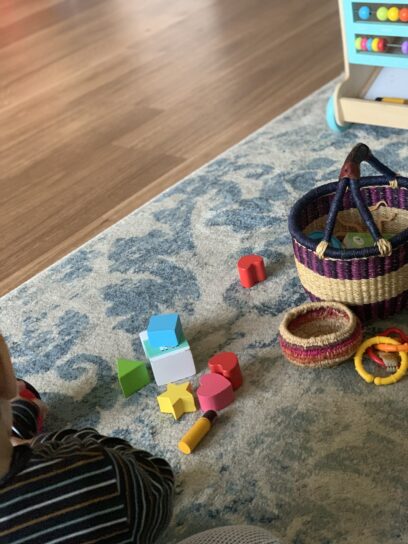Choosing toys for your baby or toddler can be an overwhelming experience. Parents often feel a lot of pressure to make sure that their child’s toy is “educational”. As a parent we can spend hours researching toys that will support brain development and independent play only to find ourselves in the toy aisle with a crying child before grabbing the brightest plastic toy that will inevitably need batteries.
We’ve all done the frenzied grab for a bright toy with light up buttons, it’s not the toy that you will see on the most curated social media pages, but it is a toy babies often reach for.
So, if you have some time to put into toy selection, what should parents be looking for?
Well, the most important thing to understand is that the thing your child is most interested in is you, the parent. Talking with you, spending time with you in the home and outside, playing with you is likely the thing they want to do the most. But let’s be honest, sometimes we would love it for our child to spend some time playing without us having to be the centre of that game.
When choosing toys there are some things you can keep in mind:
Open ended play- open ended play allows your child to set the pace and follow their interests as well as test their skills at their own pace. Toys that encourage open ended play are things like blocks that can be built into different shapes while testing their balance and coordination. For children of all ages having dress up clothes can be an excellent way for them to use their imagination and step into different roles. Items you have around the home can also facilitate open ended play, plastic bottles filled with rice, buttons or coloured rocks, jars to collect shells or flowers can lead to discussions about size, shape, texture and colour. Empty boxes of all sizes can be used to practice opening and closing, babies love to put items in a box and take them out again, often over and over, and over and over again. Empty boxes can also be stacked or taped to make buildings, trains or animals.
Safety- babies learn and explore by putting things in their mouths, this is developmentally normal so remember small items can be a choking hazard. Craft projects are great for learning, just make sure the project is developmentally appropriate, toddlers may want to eat the play doh or taste the glue, just keep your eye on them.
Allow your child to lead- even young babies have preferences for certain toys and activities, sometimes just being in a play space together with a number of toys around is a great start. Observe and be curious about what your child is drawn to, our job as parents is to delight in our child’s interest and gently encourage them to extend and expand their play.
As parents we often need to manage our own expectations- our children are individuals and children can have an intense but often short attention span. It’s common for a parent to set up what we think is an excellent game or cool craft project only to feel dejected that the game wasn’t so interesting for our child or the craft project took longer for us to set up and clean up than the actual time our child was creating. This is normal and even though it may not feel like it, children are ALWAYS learning. Our job is to try and help make it a positive experience by encouraging, delighting and seeing the activity through their eyes.
Children are much less focussed on outcomes. Maybe they got bored of the puzzle and moved on before it was finished, maybe they like you to read the same page over and over, maybe you don’t get to build the tower like the picture on the box, but all of these experiences help them to understand their world as well as who they want to be in it.
Jessica Kumar
Child and Family Health Nurse
https://coastlifemidwifery.com.au/coast-life-families/


